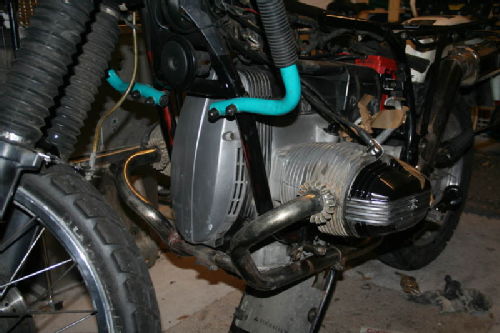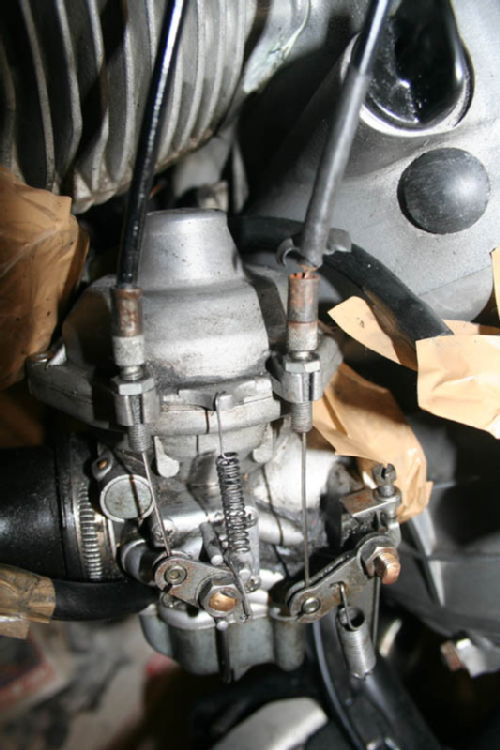- Title:
-
- Rating:

Ted Simon has a new book, Dreaming of Jupiter (published March 2007). It documents, with his usual wonderful style, his recent retracing of the original 1973 round the world ride made famous in Jupiter’s Travels. Find out more on Ted’s
Jupitalia site. Meanwhile, I’m still working on a reading of his work from 1979 – a really great book on many levels. Here’s the reason why I think it should be studied seriously.
A very great book, many agree on that. But what kind of book is it? For a while I thought that I could take an interest in the travel writing genre, having enjoyed and learnt greatly from Jupiter’s Travels. I read a lot of travel books. Some are impressive in their own ways. But I remained disappointed. Then recently I read Ted Simon’s classic for a fourth time. Half way through Africa, the second of the journey’s six continents, my mistake became obvious. It’s not really a travel book at all. It is a book of migration, diaspora, escape.
You can, if you want, read Jupiter’s Travels as a great adventure story, which it certainly is. It’s a good, if not the best, motorcycle travel book. If that’s what you want, then just read it. But there’s more. Much more. This is my response to the first two chapters…
Conventional travel books are essentially long postcards dispatched to home. ‘Wish you were here’. Or in some cases, ‘bet you’re glad you’re not here’. Eventually, as we know right from the outset, the writer gets back to the home that was always there. But there is never really a homecoming, or even a home in Jupiter’s Travels (the sequel to Jupiter’s Travels was at one point published as Riding Home, but is now entitled Riding High). Yes, the world was encircled in Simon’s tightening noose. The two ends of the journey, start and finish, twisted around each other on the return to Coventry. The rope tightened…but around thin air. The world had slipped away and refused to be suffocated.
A life, the journey, continued, jumping back and forth across the surface of the world, California, India, France, Romania etc. It continues even now. Part Jewish, part German, part Romanian. Human shrapnel dispersed the First World War and the collapse of the Ottoman Empire. Culturally English, living in America, perhaps even a little bit Indian (spiritually). Part this and part that: Ted Simon – like half the people in the world, on the move, looking for opportunity and experience. A migrant amongst migrants.
Why does this matter? What difference? Travel writing has a recurrent fault: the writer/traveller never really lets go. The journey remains as an interlude within the career. The people and places that are documented never rise above the status of curiosities. The events, the interruptions, are mere diversions. Reality, coincidence, only distracts from the essence of places, or rather landmarks, represented as recollections, travellers tales, postcards, ideals and ideas. But the world is actually full of migrants and coincidences who, to the travel writer, may seem incidental, never true to a place. The vast majority of people in or from the developing world are migrants. Accident, the interconnections between the unstable and shallow surface of things, is the real. Real places, real experiences, which may seem permanent and eternal to the travel writer, are in fact transitory and temporary constructions of coincidence. History (human and natural) proves this, although the power of the travel industry transforms the mistaken apprehensions of the travel writer into self-fulfilling prophecies: places become more like the stories that are told about them. The importance of Ted’s book is that he actually becomes a migrant (or perhaps always was one), and is thus able to encounter the world and its people on their own terms. Being a migrant amongst migrants allows the writer to value people, places and events. I can’t think of single location in its 447 pages that could ever become a new tourist attraction. They are all far too real and minor. Many of them no longer exist, having been swallowed up by development, decay or dessertification. An epic book of an epic journey, never serving the imperialistic colonising travel industry. The philosophers Deleuze and Guattari invented the term ‘minor literature’ to describe writing that comes from migrants and under-dogs. It may still be great literature. Kafka they say is minor literature. But it doesn’t come from the dominant major culture within which it swims. Jupiter’s Travels is part of a related genre: minor travel literature. This is how it’s done…
63,000 miles on that feeble little machine! Hacked together from the Meriden parts bin, amidst a near-death experience for the old Triumph company, and then the total collapse of Midlands industry. Only hours south from that miserable place the crankcase spewed its store of lubrication across the road. Failure in the 1970’s was just part of the plan, quality control to be undertaken by the customer out on the road. It was rebuilt and the journey stuttered into life again.
Half way across Lybia and the engine had already started to self-destruct. In those days a spare piston was just part of any long distance rider’s toolbox. The ability to strip and rebuild an engine somewhere out in the African bush? Taken for granted. And finally, just south of Louis Trichardt in SA (where by coincidence I once broke a gearbox) valves dropped, a sleeve corrugated, rings warped and the piston seized:
“The broken metal had penetrated everywhere and again I was struck by the force of the coincidence that all this havoc had been wrought virtually within sight of Johannesburg”. p.173
The end clearly being both nigh and divinely ordained, any normal person would have bailed out. But Ted Simon is no ordinary person. He still had another four continents to crash through (with increasing grace and understanding): interrogations by the Brazilian police, vast landscapes to carve out, portraits to draw of hundreds of people in detailed miniature, love and ideals, horrible accidents (when fishing not riding), India, and an encounter with destiny.
Apparently, a machine only works when it breaks down. Or as the journey demonstrated:
”...the interruptions were the journey.” p.132
And what a machine! A literary machine, an intellectual machine, a desiring and sometimes paranoiac machine. All wired into the bike, the journey and its improbable rhythms:
“The movement has a complex rhythm with many pulses beating…all this metal in motion, amazing that it can last for even a minute, yet it will have to function for thousands of hours [like a human heart]...Through all these pulses blending and beating I hear a slow and steady beat, moving up and down, three semi-tones apart, a second up, a second down…Is it the pulse of my own body intercepting the sound, modifying it with my bloodstream?” p.28-29
The rhythm is both dependable and on the edge of breakdown. Like consciousness itself. It acts as a single line through time and space against which the world is measured. Marking time both produces and absorbs intensity. And then looking outwards from this beat, time and its extension in space is conquered:
“From Tripoli to Sirte is three hundred miles, and I’m really flying with the engine singing for me and everything rapping along nicely. There’s a lot of rain, but I’m less nervous of the wet now, on tar at least. The land and sea lie flat out forever, and I can see the weather coming maybe fifty miles ahead. I have never seen so much weather. I can see where it begins and where it ends; I can see the blue sky above, and the approaching storms and then the good times beyond. Remarkable. Like having an overview of past and future. I am a world spinning through visible time.” p.53
And at the end of Africa:
“I have just ridden that motorcycle 12,245 miles from London…As I think about it I have a sudden and quite extraordinary flash, something I have never had before and am never able to recapture again. I see the whole of Africa in one single vision, as though illuminated by lightning.” p.183
He is of course that lightning flash, connecting thousands of disparate and ever moving points across the vastness of Africa. That interconnection of surfaces is then his essence, the essence of the migrant. He qoutes Gerard Manley Hopkins on the strangeness of being (he revived the medieval philosophy of Duns Scotus and its notion of coincidental but non-decomposable, un-dissolvable uniqueness and identity: essence through accident).
But how many people need to go through 63,000 miles of pain and pleasure to get a home, to clarify and solidify their own substance?
Why? What motivation? There was something demonic, possessing – not just the fire in the cylinder bores, although the bike is important in itself. Rather some circuit in Ted himself, circulating round and round iteratively, sometimes whirling like a tornado of doubt and fear sucking events into its core. At times the force is intense, a whirlwind ripping across the surface of the Earth. Is the journey there to satiate and extinguish that force entirely? Therapy? Or perhaps travel of this kind, and its writing, is a learning process: the question being how to tame and harness that power. How to live successfully as a migrant? Perhaps that could help us with our conflicts and confusions? In Tunisia the effects start to look dangerous. In Libya and Egypt, the raging Yom Kippur war perhaps distracts the police and the people from the effect. And then in Egypt it comes back even more fiercely:
“Could turbulence and change be ‘carried’ and transmitted like a disease? I knew I had brought excitement into those three lives, but the news from the front was always good. I wondered, unhappily, whether I was destined to leave a trail of grief and misery behind me too.” p.74
This is the fate of the migrant. But by the end of Africa, enough has been learned upon which to form a new way of being a mobile difference engine on the road. That is the art of the migrant. However for a while, when physical movement ceases, these lessons no longer make sense. The journey must be taken up once again. And then by California, the traveller and the reader are to a much greater extent able to stop the extensive spatial movement through space while still retaining an intensive movement on the spot, still governed by the habits of a well practised traveller. At this moment relations with other humans are able to deepen and stabilise, at least for a while. Ted finds love, but as the interconnection, intertwining of a set of mobile and tensile surfaces, soon to spring back into life: Australia and Asia.
Coming soon…
Dreaming of Jupiter


 Robert O'Toole
Robert O'Toole

 Please wait - comments are loading
Please wait - comments are loading









